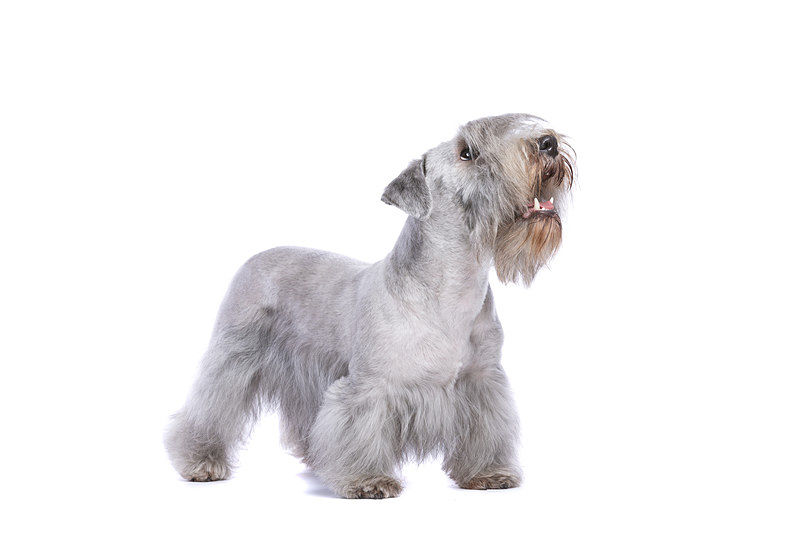Among the rarest dog breeds in the United States, the Cesky Terrier enjoys distinguished status in the Czech Republic, where it’s classified as the national dog and shows up on postage stamps. This short-legged, stretched-out, scruffy-faced earthdog – which is also sometimes called the Czech Terrier or the Bohemian Terrier – has an endearing personality and is a bit less stubborn than many other terriers, making it quite easy to train.
The trick is getting your hands on one: You may have quite the wait time ahead of you if you’d like to land yourself your very own Cesky.
(Struggling with the pronunciation? It’s actually pretty straightforward: “chess-kee.”)

The Cesky Terrier
History
The Cesky Terrier’s origin is traced to one determined breeder: the Czech geneticist Frantisek Horak, who developed the breed in the mid-20th century in an effort to refine a certain kind of small, versatile hunting dog. As the American Kennel Club explains, Horak wanted a terrier that could handily catch rats and chase “vermin” into burrows like a typical earthdog but also pursue bigger quarry in a coordinated pack – all while exhibiting a friendly and companionable demeanor away from the chase.
He achieved his goal in the Cesky Terrier, which he refined through repeated crossbreeding of the Scottish Terrier and the Sealyham Terrier. (The American Kennel Club notes that some speculate the Cesky also boasts a little Dandie Dinmont Terrier and wirehaired Dachshund in its blood.)
The Cesky Terrier made its first appearances in the U.S. and the U.K. in the late 1980s; in 2011, the American Kennel Club officially recognized the breed. The organization notes that a mere 600 or so Ceskys are registered in the U.S., which means if you’re one of the lucky owners you’ll probably run into no small number of dog enthusiasts inquiring about the breed (and maybe coveting your elegant and perky companion).
Appearance
The Cesky Terrier typically about a foot or a little less at the shoulder and weighs between 14 and 24 pounds or so.
Its distinguishing characteristics are the proportionately large, wedge-shaped head with its luxuriantly bearded muzzle and a small but muscular body’s that notably longer than it is tall. Other striking features are the triangular drop ears, the bushy eyebrows, and the silky coat.
The Cesky stands on short little feathered legs. Despite the scruffy snout, there’s an overall smoothness to this terrier’s dog profile, with the convex arc of the head, the curved neck, and a topline that rises to a high point at the loins. That almost serpentine profile continues through the natural, curved tail.
In terms of color, Cesky Terriers start out as black or black-and-tan puppies, and the coat matures to a variety of gray tones, including a dark charcoal.
Personality and temperament
The Cesky is a friendly, calm, and (with proper training and socialization) obedient terrier that bucks some of its group’s reputation for feisty stubbornness. It tends to get along well with children and can also integrate nicely with other dogs (and housecats) with the right socializing, given pack-hunting was among the abilities formative breeder Frantisek Horak selected for when developing his Bohemian Terrier.
Cesky Terriers can also serve as very good guard dogs. As you would expect, they have a healthy prey drive and thus should always be kept on leash or in enclosed areas, lest a passing squirrel or chipmunk trigger an insatiable (and often unstoppable) need to pursue.
Shedding and grooming
The Cesky Terrier isn’t a heavy shedder. Proper grooming demands weekly brushing, regular bathing, and periodic trips to a professional groomer – ideally one who’s familiar with this uncommon dog, which probably means getting a recommendation from a Cesky breeder – for clipping. (Hand-stripping of the kind used to remove dead hairs in many terriers isn’t usually practiced on the Cesky.)
You should also give your Cesky’s ears regular close inspections to get rid of any accumulated debris.
Health and lifespan
While pretty healthy overall, Cesky Terriers are vulnerable to some hereditary conditions, which given the breed’s limited gene pool isn’t hugely surprising. Those include the so-called Scotty cramp (or “wobbly Scotty”), a neurological disorder that can result in unsteady movement but typically isn’t life-threatening, as well as cerebellar abiotrophy, patellar luxation, progressive retinal atrophy, and cataracts.
A healthy Cesky Terrier will often live 12 to 15 years.
Exercise needs
The Cesky Terrier is a born-and-bred hunter and earthdog, so it definitely requires daily exercise. That said, it can do just fine with daily walks and fast-paced play sessions, which means this onetime chaser and digger of Bohemian woods can live quite happily in a city apartment.
Again, keep your Cesky on a leash when you’re out roaming the streets, and let it run free only in a fenced yard unless you want to watch it hightail at full speed after small furry and feathered creatures.
Training and intelligence
Cesky Terriers are very smart dogs that tend to respond well to training, being (as mentioned above) innately less resistant and independent-minded as some of their terrier relatives. Positive reinforcement and rewards-based sessions will tend to get you the best results.
